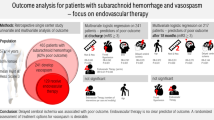Abstract
Background
Primary angioplasty has been introduced for the treatment of symptomatic cerebral vasospasm in patients with subarachnoid hemorrhage (SAH). The data regarding the therapeutic benefit of angioplasty in improving patient outcomes are limited, hence its utilization at hospitals remains controversial and currently is not reimbursed by Medicare or major insurance companies.
Methods
We analyzed the data from Nationwide Inpatient Sample (NIS), a nationally representative dataset of all admissions in the United States from 2005 to 2007. We analyzed the prevalence of angioplasty procedure for cerebral vasospasm at the national level. In-hospital mortality, discharge status, length of stay, and cost of hospitalization were compared between hospitals performing angioplasty with those not performing angioplasty in multivariable model, adjusted for patient’s age, utilization of endovascular aneurysm obliteration, and disease severity.
Results
Of the 74,356 estimated patients with nontraumatic SAH, 47% (n = 35,172) were admitted to hospitals that perform angioplasty for cerebral vasospasm and only 1307 patients (3.8%) were treated with angioplasty for vasospasm. In multivariable analysis, after adjustment for patient and hospital characteristics, we found that patients admitted to hospitals performing angioplasty had higher rates of discharge to home without supervision (OR 1.3, 95% CI: 1.1–1.6). There was no difference in in-hospital mortality, length of stay, or cost of hospitalization.
Conclusions
Our analysis suggests that the odds of a patient being discharged to home are better at hospitals performing angioplasty for cerebral vasospasm. Provision of angioplasty may be used as a surrogate marker of model of care in management of patients with SAH.
Similar content being viewed by others
References
Zubkov YN, Nikiforov BM, Shustin VA. Balloon catheter technique for dilatation of constricted cerebral arteries after aneurysmal SAH. Acta Neurochir. 1984;70:65–79.
Newell DW, Eskridge JM, Mayberg MR, Grady MS, Winn HR. Angioplasty for the treatment of symptomatic vasospasm following subarachnoid hemorrhage. J Neurosurg. 1989;71:654–60.
Zwienenberg-Lee M, Hartman J, Rudisill N, et al. Effect of prophylactic transluminal balloon angioplasty on cerebral vasospasm and outcome in patients with Fisher grade III subarachnoid hemorrhage: results of a phase II multicenter, randomized, clinical trial. Stroke. 2008;39:1759–65.
Bederson JB, Connolly ESJ, Batjer HH, et al. Guidelines for the management of aneurysmal subarachnoid hemorrhage: a statement for healthcare professionals from a special writing group of the Stroke Council, American Heart Association. Stroke. 2009;40:994–1025.
Ncd for Percutaneous Transluminal Angioplasty (PTA) (20.7. http://www.cms.hhs.gov/mcd/viewncd.asp?ncd_id=20.7&ncd_version=8&basket=ncd%3A20%2E7%3A8%3APercutaneous+Transluminal+Angioplasty+%28PTA%29.;2009.
http://notes.bluecrossmn.com/web/medpolman.nsf/8178b1c14b1e9b6b8525624f0062fe9f/eb9611de760de2128625717100690182?OpenDocument&Highlight=0,percutaneous. Accessed 12 Sept 2009.
http://www.aetna.com/cpb/medical/data/200_299/0276.html). Accessed 12 Sept 2009.
Bardach NS, Zhao S, Gress DR, Lawton MT, Johnston SC. Association between subarachnoid hemorrhage outcomes and number of cases treated at California hospitals. Stroke. 2002;33:1851–6.
Cross DWT III, Tirschwell DL, Clark MA, et al. Mortality rates after subarachnoid hemorrhage: variations according to hospital case volume in 18 states. J Neurosurg. 2003;99:810–7.
Johnston SC. Effect of endovascular services and hospital volume on cerebral aneurysm treatment outcomes. Stroke. 2000;31:111–7.
Qureshi AI, Suri MFK, Nasar A, et al. Changes in cost and outcome among US patients with stroke hospitalized in 1990 to 1991 and those hospitalized in 2000 to 2001. Stroke. 2007;38:2180–4.
Wen SW, Kramer MS. Uses of ecologic studies in the assessment of intended treatment effects. J Clin Epidemiol. 1999;52:7–12.
HCUP Databases. Healthcare Cost and Utilization Project (HCUP). Agency for Healthcare Research and Quality, Rockville, MD. www.hcup-us.ahrq.gov/nisoverview.jsp. 2009.
Shukla R, Fisher R, Fisher R. Testing of 3M’s APR-DRG Risk Adjustment for Hospital Mortality Outcomes. Abstr Acad Health Serv Res Health Policy Meet. 2002;19:11.
Berman MF, Solomon RA, Mayer SA, Johnston SC, Yung PP. Impact of hospital-related factors on outcome after treatment of cerebral aneurysms. Stroke. 2003;34:2200–7.
Mirski MA, Chang CW, Cowan R. Impact of a neuroscience intensive care unit on neurosurgical patient outcomes and cost of care: evidence-based support for an intensivist-directed specialty ICU model of care. J Neurosurg Anesthesiol. 2001;13:83–92.
Suarez JI, Zaidat OO, Suri MF, et al. Length of stay and mortality in neurocritically ill patients: impact of a specialized neurocritical care team. Crit Care Med. 2004;32:2311–7.
Matz PG. Editorial comment—spontaneous subarachnoid hemorrhage: volume, experience, and outcome. Stroke. 2003;34:2206–7.
Matchar DB. The value of stroke prevention and treatment. Neurology. 1998;51:S31–5.
Bardach NS, Olson SJ, Elkins JS, et al. Regionalization of treatment for subarachnoid hemorrhage: a cost-utility analysis. Circulation. 2004;109:2207–12.
Shea AM, Reed SD, Curtis LH, et al. Characteristics of nontraumatic subarachnoid hemorrhage in the United States in 2003. Neurosurgery. 2007;61:1131–7.
Pobereskin LH. Incidence and outcome of subarachnoid haemorrhage: a retrospective population based study. J Neurol Neurosurg Psychiatry. 2001;70:340–3.
Author information
Authors and Affiliations
Corresponding author
Rights and permissions
About this article
Cite this article
Khatri, R., Tariq, N., Vazquez, G. et al. Outcomes After Nontraumatic Subarachnoid Hemorrhage at Hospitals Offering Angioplasty for Cerebral Vasospasm: A National Level Analysis in the United States. Neurocrit Care 15, 34–41 (2011). https://doi.org/10.1007/s12028-010-9423-5
Published:
Issue Date:
DOI: https://doi.org/10.1007/s12028-010-9423-5



